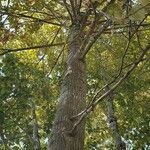Plants to 75 m, 26 dm diam.; moderately heterophyllous. Bark grayish brown, deeply furrowed. Branchlets reddish brown, becoming gray by third year, round, 1.5-3(-7) mm diam., coarse, usually densely hairy. Winter buds red, sparsely hairy or glabrous, resinous (resin red, abundant, very fragrant); terminal buds 8-15(-20) mm; flowering buds clustered distally on branchlets, 18-20 mm. Leaves: petiole cylindrical or distally slightly flattened in plane of blade (often markedly swollen distally), 1-5(-9.5) cm, 1/2 blade length, (glabrous or sparsely pubescent); blade usually triangular-ovate or narrowly ovate to cordate, (3-) 5-9(-15) × (1-)2.5-6(-10) cm, w/l = 1/2-2/3, base rounded to cordate, basilaminar glands 0-2, round, margins not translucent, not ciliate, apex obtuse to acute, abaxial surface white to grayish white or greenish white with red resin stains, sparsely pubescent, adaxial dark green, glabrous; preformed blade margins very finely, evenly crenate-serrate throughout, teeth (20-)35-40 (-50) on each side, sinuses 0.1-0.4 mm deep; neoformed blade margins finely, evenly crenate-serrate throughout, teeth (25-)40-60 on each side, sinuses 0.2-0.6 mm deep. Catkins densely (10-)25-50(-90)-flowered, (4.5-) 7-10(-17 in fruit) cm; floral bract apex deeply cut, not ciliate. Pedicels 0.5-2.5(-3 in fruit) mm. Flowers: discs broadly cup-shaped, not obviously oblique, entire, 4-6 mm diam.; stamens 30-50(-60); anthers truncate; ovary 3-or 4-carpelled, spherical, (hairy); stigmas 2-4, platelike, expanded, spreading. Capsules spherical, (6-) 7-9 mm, densely hairy to glabrate, 3-or 4-valved. Seeds (6-)10-15(-19) per placenta. 2n = 38.
More
Large tree, almost pyramidal when young, suckering moderately. Bark grey, fissured, peeling when young. Shoots somewhat angled, brown. Buds and very young shoots very viscid and balsam-scented, glabrous. Petioles to c. 9 cm long, terete, glabrous. Lamina to 13-(18) × 10 cm, usually deltoid-ovate or ovate, sometimes narrow-ovate, greenish white below, glabrous except for ciliolate margin, ± green when very young; veins green above; margin without translucent band, crenate-serrulate; base broad-cuneate, truncate or subcordate, usually glandless; apex acute to short-acuminate. Catkins ♂, pendulous, to c. 10 cm long. Rachis ± puberulent. Bracts 3-4 mm long excluding filiform teeth, hairy, whitish. cup-shaped disc 2-3 mm deep, oblique, glabrous. Stamens 30-90; anthers crimson.
A tree that loses its leaves. The bark is rough. It grows 50 m high. The young buds and leaves have a sweet smell. The leaves are heart shaped or triangle shaped and on long stalks. They are rounded at the base and pointed at the tip. There are fine teeth along the edge. Male and female flowers are on separate tress. The flowers on in long catkins that hand down.




